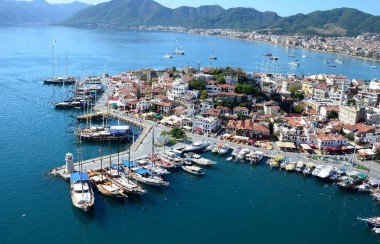Marmaris Region
Marmaris is a port city and tourist resort on the Mediterranean coast, located in Muğla Province, southwest Turkey, along the shoreline of the Turkish Riviera.
Marmaris' main source of income is tourism. It is located between two intersecting sets of mountains by the sea, though following a construction boom in the 1980s, little is left of the sleepy fishing village that Marmaris was until the late 20th century. In 2010, the city's population was 30,957,[3] and peaks at around 300,000 to 400,000 people during the tourist season.
It is also a centre for sailing and diving, possessing two major and several smaller marinas. It is a popular wintering location for hundreds of cruising boaters, being also served by the nearby Dalaman Airport.
History
Although it is not certain when Marmaris was founded, in the 6th century BC the site was known as Physkos, also Latinized as Physcus, and was in a part of Caria that belonged to Rhodes, contained a magnificent harbour and a grove sacred to Leto. According to the historian Herodotus, there had been a castle on the site since 3000 BC. In 334 BC, Caria was invaded by Alexander the Great and the castle of Physkos was besieged. The 600 inhabitants of the town realised that they had no chance against the invading army and burned their valuables in the castle before escaping to the hills with their women and children. The invaders, well aware of the strategic value of the castle, repaired the destroyed sections to house a few hundred soldiers before the main army returned home. The city became known as Marmaris during the period of the Beylik of Menteşe; the name derives from Greek màrmaron (marble), in Turkish mermer, in reference to the rich deposits of marble in the region, and the prominent role of the city's port in the marble trade. Marmaris Castle Sehir Island in Marmaris In the mid-fifteenth century, Sultan Mehmed the Conqueror conquered and united the various tribes and kingdoms of Anatolia and the Balkans, and acquired Constantinople. The Knights of St. John, based in Rhodes had fought the Ottoman Turks for many years; they also withstood the onslaughts of Mehmed II. When sultan Suleiman the Magnificent set out for the conquest of Rhodes, Marmaris served as a base for the Ottoman Navy and Marmaris Castle was rebuilt from scratch in 1522. In 1801 a British force of 120 ships under Admiral Keith and 14,000 troops under General Abercromby anchored in the bay for eight weeks, training and resupplying for their mission to end the French campaign in Egypt and Syria.[8] The 1957 Fethiye earthquakes almost completely destroyed the city. Only the Marmaris Castle and the historic buildings surrounding the fortress were left undamaged. Since 1979, renovation work has been continuing at the castle. Under the auspices of the Ministry of Culture, the castle was converted into a museum. There are seven galleries. The largest is used as an exhibition hall, the courtyard is decorated with seasonal flowers. Built at the same time as the castle in the bazaar, there is also a small Ottoman caravanserai built by Suleiman's mother Ayşe Hafsa Sultan.
Marmaris Tours
Related Tours
We Proudly Design Tailor Made Itineraries For Individuals And Groups.











